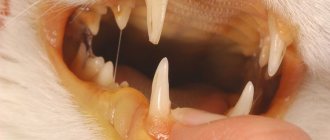Signs Causes of megaesophagus Diagnosis Treatment
Megaesophagus is an expansion of the entire esophagus due to its paresis or paralysis.
Normally, the motility of the esophagus ensures the movement of food and water from the pharynx to the stomach. The disease is much more common in dogs than in cats. There are congenital and acquired megaesophagus. In the first case, the disease is recorded in puppies and young dogs (approximately 1/3 of cases). Moreover, dilation of the esophagus can be observed in all puppies in the litter. Thus, in certain dog breeds, megaesophagus should be considered a genetic disease (wire fox terrier, miniature schnauzer, German shepherd, Great Dane, Irish setter).
Acquired megaesophagus. Diagnosed in animals of any age, although most often in older animals. There are idiopathic megaesophagus (the exact cause has not been identified) and secondary megaesophagus (develops as a consequence of the underlying disease, for example, myasthenia gravis, hypothyroidism).
In puppies, pathology can occur as a consequence of the formation of a congenital vascular anomaly (persistent right aortic arch). In this case, the vascular ring compresses the esophagus and mechanically interferes with the normal motility of the esophagus and the movement of food.
When making a diagnosis, it is very important to find out what is causing the dilation of the esophagus. For example, surgical treatment is indicated for puppies with an abnormal location of the aorta, and hormone replacement therapy is indicated for dogs with hypothyroidism.
Signs
Characteristic symptoms:
- regurgitation (regurgitation) of food, water;
- decreased appetite, refusal to eat, or vice versa, constant severe hunger;
- difficulty swallowing, frequent swallowing;
- profuse drooling;
- sour, foul breath;
- weight loss;
- retardation in growth and development;
- constant attempts to clear the throat, accompanied by dry, coughing sounds.
Aspiration pneumonia is a common complication of megaesophagus. When coughing or regurgitation, food debris is thrown into the upper respiratory tract, which provokes a strong inflammatory reaction.
Megaesophagus
Etiology
Megaesophagus is a disease in which the esophagus dilates due to loss of peristaltic function. Its etiology is unknown, although it may be congenital or secondary to other pathological conditions. Megaesophagus is caused by a dysfunction of the physiological sphincter dilatation.
Primary megaesophagus appears to be caused by a deficiency of sensory neurons innervating the esophagus or neurons innervating or located in the swallowing center itself. Since there are no sensory impulses, there is no sensation of the presence of a bolus of food. Therefore, peristalsis does not begin, and the distal sphincter does not widen, resulting in food remaining in the esophagus. Any pathology of the path that controls reflex peristalsis in the esophagus, associated with the passage of a bolus of food, leads to its retention in the esophagus. The disease may also be a consequence of asynchronous motor function of the esophagus and distal esophageal sphincter. Additionally, the condition seen in very young dogs is thought to result from immaturity of the esophageal tissue and often resolves with age. In adult animals, the problem turns out to be a consequence of an acquired defect in the neurological innervation of the esophagus.
Secondary megaesophagus may be associated with:
- myasthenia;
- poliomyositis;
- systemic lupus erythematosus;
- hypoadrenocorticosis;
- lead poisoning.
In cats, secondary megaesophagus occurs as part of the typical clinical presentation of feline familial autonomic dysfunction syndrome. Myasthenia gravis has also been reported in cats in association with megaesophagus. Megaesophagus caused by pyloric obstruction, which improved after pyloromyotomy, has also been observed in cats.
It is assumed that aspiration pneumonia, common in megaesophagus, is a consequence of inhibition of breath holding during swallowing by the respiratory center.
Megaesophagus is reported to be most common in the Great Dane, Irish Setter, and German Shepherd (Harvey et al., 1974). There are also hypotheses about the inheritance of the disease as a simple autosomal recessive gene in miniature schnauzers and fox terriers (Cox et al., 1984), and the inheritance of the disease in cats has also been confirmed as a recessive, not related to gender (Clifford et al., 1971). The incidence is higher in female dogs (Harvey et al., 1974), and cats are generally affected less frequently than dogs.
Clinical diagnosis
Classic signs of megaesophagus are depression and weight loss in dogs that regurgitate undigested food and fluid. At the onset of the disease, regurgitation may be intermittent, and in some cases the owner does not observe regurgitation at all, and only symptoms due to aspiration pneumonia are detected.
Regurgitation occurs approximately 12 hours after feeding, and in these cases it is usually a small amount of undigested food, often sausage-shaped and coated with mucus. Regurgitation immediately after feeding occurs more often during physical exertion, excitement or stress. The regurgitated food does not contain bile and has a high pH value, which indicates that the food did not have time to reach the stomach. Many owners complain about their cat or dog vomiting, when in fact it is passive regurgitation. Sometimes owners talk about gagging movements made by the animal, and this, apparently, occurs due to passive regurgitation into the throat, which causes asphyxia. Often the patient immediately swallows the regurgitated food, and this may be repeated several times.
Causes of megaesophagus
The causes of megaesophagus in dogs and cats are divided into two groups - idiopathic megaesophagus, and secondary, as a result of a number of pathologies:
- myasthenia gravis;
- brain stem damage;
- polymyositis, poliomyopathy;
- polyneuritis;
- tetanus, carnivore plague;
- polyradiculoneuritis;
- autoimmune diseases;
- toxic causes (lead poisoning, poisoning with cholinesterase inhibitors);
- axonal neuropathy;
- persistent right aortic arch;
- esophagitis, mediastinitis;
- Addison's disease;
- hypothyroidism
What it is?
The name of the pathology consists of two Latin terms. The first means “large”, the second means “esophagus”. True, the length of the organ does not change in any way. It grows in width. More precisely, the lumen of the esophagus greatly increases, inside which a kind of “pocket” is formed. In particularly advanced cases, x-rays show a picture as if the dog had swallowed a balloon. At the same time, the lumen of the esophagus increases so that even a full stomach can be smaller in size.
Pathology can be divided into four main types: primary and secondary megaesophagus, congenital and acquired. In the first case, the “Megaesophagus” exists on its own, being the only disease. In the second, it is only a consequence of the pet’s existing pathology. Accordingly, the congenital variety is present in the dog from its very birth, in most cases being a consequence of disorders of intrauterine development and/or a genetic or autoimmune disease of the mother. Dogs become ill with acquired megaesophagus as a result of some acute or chronic diseases of the gastrointestinal tract.
But it is not always possible to draw an exact line between these types of ailments. Thus, esophagitis, that is, inflammation of the esophagus, can be both a consequence and a cause of dilatation (expansion) of the organ. And finding out what exactly appeared first is not possible in all cases.
Diagnostics
Based on anamnesis and clinical picture. It is extremely important to find out whether the enlargement of the esophagus is an independent disease, or whether the pathology is secondary to some other problem. X-rays using contrast media are very indicative (allows you to assess the degree of expansion of the esophagus and the nature of the changes). Laboratory diagnostics includes a general clinical, biochemical blood test, virological study, and hormone test. If necessary, esophagoscopy is performed to make an accurate diagnosis (allows us to exclude tumor formations, foreign bodies, and esophageal obstruction).
Megaesophagus of cats and dogs
Megaesophagus of cats and dogs
Megaesophagus (from the Latin Oesophagus - esophagus and mega - significant increase in size) is a pathological expansion of the esophagus associated with a violation of its motility (peristalsis), due to its paresis or paralysis
The esophagus is a tube-like organ connecting the pharynx and stomach, through which food and liquid move from the mouth to the stomach.
Between the pharynx and the esophagus is the upper esophageal sphincter, formed by the cricopharyngeal and thyropharyngeal striated muscles, as well as the cricoid cartilage. This sphincter prevents reflux (backward movement) and aspiration (entry into the respiratory tract) of food masses or liquids, since its muscles relax only at the moment of swallowing food.
Normally, the motility of the esophagus ensures the movement of food and water from the pharynx to the stomach, while the empty esophagus collapses under the action of muscles, and if their function is impaired, it is constantly dilated
There are congenital and acquired megaesophagus.
Megaesophagus on x-ray
Congenital megaesophagus is often reported in puppies and young dogs. In puppies, pathology can occur as a consequence of the formation of a congenital vascular anomaly (persistent right aortic arch). In this case, the vascular ring compresses the esophagus and mechanically prevents the normal movement of food.
Acquired megaesophagus is diagnosed in animals of any age. There are idiopathic megaesophagus (the exact cause has not been identified) and secondary megaesophagus (develops as a consequence of the underlying disease).
Primary (ideopathic) megaesophagus is associated with a violation of signal transmission from nerve endings to the muscles of the esophagus. As a result, there is no peristaltic movement of the esophagus, which leads to retention of the food coma in it.
Secondary megaesophagus usually occurs due to myasthenia gravis (pathological fatigue and muscle weakness) of the esophagus. It develops as a result of systemic diseases: canine hypothyroidism (decreased levels of thyroid hormones), poliomyositis (inflammation of the muscular layer of the esophagus) and systemic lupus erythematosus (an autoimmune disease of the connective tissue).
When making a diagnosis, it is very important to find out what is causing the dilation of the esophagus. Thus, surgical treatment is indicated for puppies with an abnormal location of the aorta, and hormone replacement therapy for dogs with hypothyroidism.
Common complications of megaesophagus manifest themselves in the form of esophagitis, erosion of the mucous membranes of the esophagus, mediastenitis, and perforation of the esophagus can also occur. When aspiration of the esophagus with feed masses and during regurgitation (regurgitation of food), aspiration pneumonia can develop.
The most susceptible dog breeds are: Wire Fox Terrier, Miniature Schnauzer, Dalmatian, German Shepherd, Great Dane, Irish Setter, Newfoundland and Greyhound.
Symptoms
Megaesophagus manifests itself in regurgitation of undigested food immediately after feeding, or several hours later. The food lump has a characteristic, elongated shape and, as a rule, is enclosed in a mucous membrane without admixture of gastric juice and bile, which is evidence that the food has not reached the stomach.
Very often, owners confuse regurgitation and vomiting when they talk about “vomiting.” During regurgitation with megaesophagus , an attack of asphyxia occurs, the dog seems to suffocate.
The onset of the disease practically does not manifest itself in any way, the appetite is normal, sometimes “ravenous hunger” appears when the animal constantly asks for food due to the fact that the food does not reach the stomach. Animals exhibit cachexia (extreme exhaustion of the body).
Clinical manifestations of megaesophagus have the same type of symptoms (due to the expansion of the lumen of the esophagus and stagnation of food masses in it): regurgitation (rapid movement of fluid in the direction opposite to normal), regurgitation of mucus and foam, frequent vomiting of stagnant food, in severe cases the presence of soft swelling in the neck area , increasing after feeding and “pulsating” during breathing, difficulty swallowing, frequent swallowing, profuse salivation, sour, foul breath, dyspnea (difficulty breathing, shortness of breath).
Secondly, there are symptoms caused by laryngotracheitis and aspiration pneumonia, which occurs as a result of passive flow of esophageal contents into the trachea during sleep.
The most common complication of megaesophagus is aspiration pneumonia.
Aspiration pneumonia develops due to the entry of tiny particles of food into the respiratory tract. This occurs due to a violation of the reflex mechanism of holding the breath during the act of swallowing. Aspiration pneumonia is the most common cause of death in animals with megaesophagus. It is characterized by cough, shortness of breath, fever, and general weakness.
With further development of the disease, inflammation of the mucous and muscular membranes of the esophagus occurs, which can result in degeneration of the nerve plexuses in the muscles of the esophagus, its perforation and the entry of undigested food into the chest cavity. The latter, in turn, can result in the death of the animal without adequate and emergency surgical care.
Owners of sick animals rarely pay attention to the initial manifestations of the disease, such as regurgitation or coughing after eating. Clinical symptoms increase gradually over several weeks or even months. The diagnosis of “megaesophagus” is often made in advanced stages of the disease, when a constant hoarse cough “to the point of vomiting” appears. Animals, as a rule, die as a result of severe aspiration pneumonia and nutritional exhaustion.
Diagnostics
X-ray examination of the esophagus after barium administration
Diagnosis of megaesophagus is based on medical history and clinical picture. It is extremely important to find out whether the enlargement of the esophagus is an independent disease, or whether the pathology is secondary to some other problem.
Indicative is radiography using contrast media (allows you to assess the degree of expansion of the esophagus, the nature of the changes).
Laboratory diagnostics includes clinical and biochemical blood tests, virological studies, and hormone tests. If necessary, esophagoscopy is performed to make an accurate diagnosis (allows us to exclude tumor formations, foreign bodies, and esophageal obstruction).
Differential diagnosis
Differential diagnosis is carried out with an anomaly of the aortic arch, a tumor of the esophagus and stenosis of the cardiac part of the esophagus.
Treatment
Treatment of megaesophagus is carried out with medication and with the help of supportive therapy - adherence to feeding regimen and diet. In some cases, surgery is necessary.
Treatment of megaesophagus
Feeding is carried out in an upright position (avoids aspiration and pneumonia). The diet should include low fat food and the consistency of the food should be close to a milkshake consistency. Meals are divided into 3-4 times. The liquid should also be supplied with the animal's neck in a vertical position.
Symptomatic treatment is prescribed, aimed at restoring the tone of the esophageal muscles and moving food into the stomach.
If aspiration pneumonia occurs, complex treatment with antibiotics and symptomatic drugs that alleviate the animal’s condition (antipyretics, antiemetics, etc.) is necessary.
If hypothyroidism is established in dogs, hormone replacement therapy is performed.
If drug therapy is unsuccessful and surgical intervention is necessary, a modified Heller myotomy is used, in which the esophageal muscle and gastric cardia muscle are dissected, which facilitates the passage of food into the stomach. However, this does not cure the dilation of the esophagus. After surgery, lifelong use of medications that improve esophageal motility is indicated.
The prognosis depends on the degree of expansion of the esophagus and the cause of the pathological changes. Most dogs with megaesophagus require lifelong therapy. In the case of secondary megaesophagus or congenital pathology, the prognosis is favorable, especially if treatment was started in a timely manner.
Therapeutic techniques
As a rule, treatment of esophagitis is carried out on an outpatient basis; there are often no indications for hospitalization. Only in severe cases, when there are large ulcers on the surface of the esophagus that could perforate the organ wall, is surgery indicated. It can also help animals with fibrosis of the esophagus, since this pathology cannot be cured by other methods.
Also in such situations, the animal needs regular parenteral nutrition (intravenous administration of nutritional solutions), since it cannot eat normally.
An important method of treating inflammation of the esophagus is suppression (inhibition) of gastric juice synthesis . It is necessary to give the organ mucosa time to recover. “Human” Omeprazole, which is actively used for the treatment of gastritis and ulcers, has proven itself to be excellent. Antacids should be prescribed for at least two days, since treatment for a shorter period of time rarely produces a positive effect.
In case of severe pain reaction, sedatives are prescribed. When the pet begins to recover, he is prescribed a light diet, mainly consisting of broths and pureed vegetables. This is how esophagitis in animals is treated.
General information
This is the name for inflammation of the mucous membrane of the esophagus . The prevalence in dogs is unknown, but it is likely to be quite widespread. The problem is inadequate diagnosis associated with poor equipment in many veterinary clinics.
Pay special attention to a pet that begins to vomit within minutes of any anesthesia. It is very likely that he has reflux esophagitis. No geographical or age-sex predisposing factors have yet been identified (most likely, they simply do not exist). Dogs of all breeds, sexes and ages are affected. For certain reasons (wearing teeth, periodontal disease), older dogs get sick somewhat more often.
Although... Certain breeds (such as brachycephalic varieties and Shar-Peis in particular) are at increased risk of developing a hiatal hernia, a pathological dysfunction of the lower esophageal sphincter. Practicing veterinarians note that there are more cases of esophagitis in such animals.
Bitches are also at risk (according to the global veterinary community), but there are no real studies to confirm this. In addition, so far no one has been able to explain what could cause this.
Inflammation of the esophagus as a cause of its expansion
A fairly common cause of dilation of the esophagus is its own inflammation. When organ tissues are affected by some negative environmental factors, including the action of irritating and caustic substances, they lose elasticity and firmness, which leads to the formation of a “pocket”. Because of this, esophagitis, which is not taken seriously by many specialists, is actually quite a serious disease that needs to be treated immediately.
How can you tell if your cat has an inflamed esophagus? The clinical picture of the pathology is not very characteristic, the symptoms are few. So, the cat may vomit, he is reluctant and eats little (it hurts), he tries to drink more or prefers semi-liquid, soft food.
Treatment
Therapy includes elevated feeding and/or gastrostomy tube placement and nutritious, high-calorie diets. Surgical treatment remains controversial.
We suggest you read: Description of the main types of sedatives for cats
Pharmacological management using drugs that relax the gastroesophageal sphincter or enhance the strength of esophageal reduction has been reported to be disappointing, although sildenafil, a phosphodiesterase-5 inhibitor, has been reported to have a pronounced effect on esophageal contractility in cats, altering the propagation and amplitude of esophageal contractions. Nifedipine, a calcium channel blocker, resulted in transient clinical improvement (2 months) in an adult German shepherd dog with megaesophagus.
Animals with secondary acquired megaesophagus should be appropriately differentiated from other esophageal disorders and treated. Dogs suffering from myasthenia gravis should be treated with pyridostigmine (1.0-3.0 mg/kg PO 2 rvd) and/or corticosteroids (prednisone 1.0-2.0 mg/kg PO or PC 2 rvd), dogs suffering from hypothyroidism , should be treated with levothyroxine (22 mcg/kg PO 2 rvd), and dogs affected by polymyositis should be treated with prednisone (1.0-2.0 mg/kg PO 2 rvd).
If a secondary disease can be excluded, therapy for a congenital or acquired idiopathic patient with megaesophagus should focus on nutritional management and treatment of aspiration pneumonia. Affected animals should be fed a high-calorie diet, with small, frequent feedings, and in an elevated or upright position to take advantage of gravity drainage through a non-peristaltic esophagus.
The consistency of the diet should be formulated to produce the least clinical signs. Some animals tolerate liquid diets well, while others show improvement with solid food. Animals that cannot maintain adequate nutritional balance when administered orally must be fed by a temporary or permanent gastrostomy tube.
Gastrostomy tubes can be placed surgically or percutaneously using endoscopic guidance.
Pulmonary infections should be identified by determining the type of bacterial culture and antibiotic sensitivity selected for the offending organism.
This examination can be achieved by trans- or endotracheal lavage or bronchoalveolar lavage during endoscopy. Prokinetic (eg, metoclopramide or cisapride) therapy has been advocated to stimulate esophageal motility in affected animals, however metoclopramide and cisapride are not likely to have a significant effect on the striated muscle of the canine esophageal body.
Megaesophagus in dogs
Megaesophagus consists of pathological and generalized dilatation of the esophagus that occurs with decreased motility (hypomobility) of the canine esophagus; that is, the esophagus makes movements called peristalsis, which help the transit of food, when this mobility is impaired, and in turn it is the transit of food. Megaesophagus can be congenital or acquired. Congenital megaesophagus This is normal in puppies, usually when they start a solid diet. Acquired megaesophagus . On the other hand, it can affect adult dogs and is caused by various reasons such as the presence of a foreign body or myasthenia gravis (muscle weakness) in the body…
Causes and main predisposing factors
Most often, mechanical or chemical injury to the mucous membrane is to blame . That is, in cases where a dog eats food contaminated with household chemicals, or greedily eats chicken bones, the prospects for the esophagus are not very bright... It happens that inflammation develops against the background of persistent or frequent vomiting, which appears against the background of poisoning or the action of helminths.
Often, inflammation of the esophagus occurs in those dogs whose owners forcefully try to feed them deworming tablets , without even trying to first crush them to a more “sane” state. Also interesting are cases of the disease that appeared after ingestion of various foreign bodies. As a rule, “ill-mannered” dogs who love to visit all the local garbage cans suffer from this. By the way, esophagitis in cats is often caused by hairballs, which are a “headache” for many representatives of long-haired breeds.











